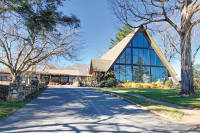Police wrestle bear cub into custody
A baby bear went on a romp through downtown Waynesville last week before finally being cornered and captured by police officers on a preschool playground on Main Street.
The bear was first spotted on the playground of the First United Methodist Church preschool. Preschool staff called the police department then tracked the bear cub as it moved through downtown, keeping tabs on its whereabouts until police arrived.
Two blocks later, it jumped the fence of another preschool playground, First Baptist Church.
It was a stroke of luck for those trying to catch the bear. The sunken playground is surrounded by a brick wall or fence on all sides. A growing field of spectators pitched in, surrounding the playground and running interference to keep the bear confined while waiting for an animal control officer.
By now, three Waynesville police officers had arrived and orchestrated the efforts to keep the bear inside the playground, shooing and clapping at it each time it attempted to scale the wall or climb the fence. But the cub was growing increasingly agitated, fueled partly by the mounting number of onlookers with cell phone cameras encircling the playground. One spectator fetched a rope from his truck, tied a loop in it and began trying to lasso the bear cub.
With still no sign of animal control officers and no indication of how soon they would arrive, Waynesville Police Officer Kenny Aldridge decided the officers needed to act.
He jumped the fence into the playground and began working the bear cub into a corner.
“I was somewhat concerned about all the people. A small bear can still do major damage,” Aldridge said. “I was also afraid it would get spooked and get out in traffic.”
Meanwhile, Deputy Micah Phillips donned his leather gloves and began moving in on the bear. Aldridge chased the cub toward a brick wall, and as it began to scramble up, Phillips seized the moment. He dashed up behind the bear and quick as a flash grabbed it by the scruff of its neck.
The bear cub turned into a writhing, flailing ball of fur and claws, which were easily two inches long despite his stature of only 20 pounds or so. Letting go wasn’t an option at this point, so Phillips held tight, even as the bear cub extended both his paws, and reached behind his head groping for his captor. The bear’s claws closed in on Phillips’ wrist, but luckily his gloves proved just long enough — the bear’s groping claws came within half an inch of the top of Phillips’ gloves. Phillips strolled out of the playground, opened the back door of his patrol car and flung the bear inside before slamming the car door.
“I’ve never grabbed a bear before,” Phillips said. When asked how he knew his gloves were just long enough to spare his wrist from being torn to shreds, “That was just a gamble,” he said.
The baby bear’s mother was nowhere to be seen — perhaps killed, but most likely out of the picture due to the food shortage facing black bears throughout the mountains this fall. Mothers unable to provide for all their young will abandon some of their cubs. A cub going into the winter without its mother is certain death, however. The cubs don’t yet know how to find food on their own, nor do they understand how to den up and hibernate for the long winter.
Making matters worse, the bear cub had not faired well on its own and was clearly malnourished and underweight for its age, hardly equipped to survive the cold season ahead.
The bear cub was taken to a bear rehabilitation and rescue center where it will spend the winter and then be released into the wild next summer.
Close encounters of the bear kind
The battle has been an epic one, but Wolfgang Restaurant in Highlands might have finally gotten the best of a bear addicted to a nightly feast of its trash.
The bear had gotten into the unfortunate habit of visiting the restaurant’s trashcans, which were kept in an alley out back, in the wee hours of the morning.
“They would drag the garbage bag across Village Square and there would be piles of garbage and bear poop everywhere,” said Cynthia Strain.
Strain, an expert and leader of a bear education group, suggested ammonia.
“The nights they sprayed their garbage cans and bags with ammonia, they wouldn’t get into it. But the nights they forgot, the bears would get all over it,” Strain said.
That worked for a while, but the bears hankering for trash eventually got he better of them. They overcame their distaste for ammonia and began their nightly trash forays once more.
“They finally worked out a deal where Wolfgang gave the back door key for the town garbage men and would leave the garbage inside the backdoor,” Strain said. The deal was forged just last week, in a win-win deal for everyone, except perhaps the bears.
“The garbage men were happy to do it, because they wound up spending a great deal of time cleaning up the garbage from the street,” Strain said.
While getting into trash is one of the top bear problems faced by mountaintop islands of Highlands and Cashiers, bears have started to find their way into people’s homes.
“If they smell food they will come right in the screen door of the house,” Strain said.
“One fellow had a bear rip his screen door off three times trying to get to the bird seed on his porch,” Strain said.
Strain realized that conflicts between bears and people, particularly in the Highlands and Cashiers area, would only continue to rise — as bears became bolder and people more plentiful.
“Over the years we started hearing more and more and more problems with bears. People just didn’t know what to do. We thought someone needed to step in and educate the public,” Strain said. “There wasn’t anyone in a position to help these people with information and guidance”
So Strain helped start a nonprofit called B.E.A.R., which operates under the WNC Alliance, a regional environmental group and stands for Bear Education and Resources.
“They call and say they are having a lot of problems with bears in their community and want someone to come talk to them and tell them what to do and what not to do,” Strain said. “When bears do things like come in to your house and up on your deck, they are losing their natural fear of people. It is a lot easier to prevent problems than solve problems.”
Inadvertent carelessness, such as leaving out birdseed and dog food, is the biggest challenge Strain is trying to combat. But sadly, she has heard stories of people making and feeding the bears peanut butter sandwiches and coaxing them into yards.
Two groups in the Highlands-Cashiers area are working to teach residents there — and across WNC — how to better co-exist with black bears. Bear encounters are particularly frequent on the plateau area of southern Jackson and southeastern Macon counties where the two communities are situated.
Feeding bears is the biggest mistake a person can make, said Strain. Bears that lose their fear of humans to the point of showing aggression often get put down.
“It’s a bad year for bears, but that doesn’t mean you should feed them,” she said. “Because then you create serious problems that could end up causing the death of the bear. Once bears become accustomed to food, they associate humans with food — and lose their fear. And the more conditioned they get, the more aggressive they become.”
John Edwards, the founder of Mountain Wildlife Days and who lives in Sapphire Valley Resort, helps represent the interests of black bear enthusiasts. This is done with the help of the Bear Smart Initiative sponsored by the Jackson-Macon Conservation Alliance, Wild South and other experts.
“There is pretty much a constant bear issue here,” Edwards said of Sapphire and that community. Like Strain, Edwards warned against feeding bears.
“That can create a problem in a hurry,” Edwards said. “If one person throws food off a deck to a wild animal, they come back.”
Strain has heard a few stories of people being swatted by bears.
A man in Highlands walked out of his house at night and nearly stumbled into a bear.
“He turned and ran, and it triggered an instinct in the bear to chase him. He was running up the stairs of his house and the bear swatted at his leg and scratched his leg before he got inside, so those things will happen,” Strain said.
In a similar story, a lady flipped on her outside lights to see why her dog was barking. She saw a bear cub in her yard and stepped outside for a closer look.
“What she didn’t realize is she just stepped out in between the cub and its mother. That’s something you never want to do,” Strain said. “The mother swatted at the woman and scratched her.”
Stories such as these have led to a fear by some to go out in their yard at night.
“I would not be afraid, but I know how to read a bear’s behavior. The only time to be afraid is if you startle a bear — if they don’t hear, smell or see you coming,” Strain said.
How to act during a bear encounter is another of the bear topics Strain and her group cover during their talks and programs. Chiefly, speak to the bear gently, don’t make eye contact and back away slowly. Don’t, under any circumstances, run.
“If they do charge you, it is a bluff charge,” Strain said.
A mother bear’s finely honed biological clock
Bears have to pack on serious pounds in the fall — three to four pounds a day, or about 25,000 calories — in order to make it through hibernation.
It’s especially critical for the females. They give birth while hibernating and sustain their cubs in their den until spring arrives.
Baby cubs are born in January weighing less than a pound. Essentially born premature, the cubs latch on to their mothers and nurse around the clock for the rest of winter. The mother converts her vast fat stores to milk, producing up to 50 pounds of milk despite taking in no food or calories herself. Cubs weigh eight pounds by the time they emerge from the den in April.
A mother bear calibrates the number of cubs she has based on how well she can nourish them. While bears mate in June, development of the embryo is delayed until fall. A bundle of fertilized eggs simply sits in the mother’s uterus, waiting to see how much weight she’ll gain during the pre-hibernation feeding frenzy. When — and if — she hits the target weight gain, the bundle of eggs pops open and implants in the uterus.
Last year was a great year for acorns, bear’s chief food source, resulting in more cubs than normal. The large number of cubs born in spring has made matters even worse during the acorn and food shortage this fall.
Forget the birdfeeders and dog bowls, this bear went straight for the kitchen cupboard
Steve Hewitt of the Villages of Plott Creek in Haywood County already has a pretty good idea about the concept of live and let live when it comes to bears.
There have been a number of bear sightings in his community, and one very close sighting indeed for he and his wife. About two weeks ago, at about 4 or 5 p.m., his wife thought she saw the couple’s black dog walking around outside the house.
It wasn’t — it was a bear and her cubs, “and they weren’t concerned” at all about human interest in their movements, Hewitt said.
The couple doesn’t keep bird feeders in the yard, though a neighbor had bird feeders torn down by bears. Hewitt also isn’t terribly worried about his dog tangling with a bear.
“He’s not a real courageous dog,” he explained. Hewitt believes people just need to live with the reality of bears, and leave them alone to go about their bear business.
Along with many other subdivisions and residential areas in Western North Carolina, the Villages of Plott Creek has sent out warnings to residents about the increase in bear activity.
Last week, in a newsletter, it was noted: “There have been several black bear sightings within and around the Villages of Plott Creek in the past four months. We are sending this notice to inform all residents to use caution with your children, pets, bird feeders and other food items in yards, walking and driving in the Villages. To date, none of the sightings have shown aggression other than damaging bird feeders and searching for natural food in yards.”
Bear sightings and bear visits are also taking place, of course, in other communities. Ray Daniel, who lives in the Cashiers community on Breedlove Road with his wife, Janet, has replaced three window screens torn out by bears.
The bears have actually made their way into the couple’s house on at least two occasions. Three or four weeks ago, the Daniels awoke to discover a bear had ripped through a screen and gotten in the kitchen — forensic proof, in the form of a perfect imprint of a bear paw, was discovered on a stainless-steel kitchen appliance.
The bear apparently ate chocolate chips, crackers and cookies, plus peaches and bananas.
“It didn’t like the oatmeal — the bear left that,” Daniel said, adding that peach pits and banana peels were left on the porch. Not long after that particular break-in, a bear got into the couple’s basement where trashcans were stored. Trash was strewn over the yard.
A helpful friend told the couple that they understood bears dislike the smell of Clorox. And, in fact, after Daniel scrubbed out the trashcans with the cleaner, the bears haven’t been back. But they’ve been seen around the community by neighbors, leaving the Daniels to keep a wary eye out for their unwelcome breakfast guests.
Bear encounters: Bears on the prowl for food lead to increased sightings
A bad year for acorns in the higher elevations, coupled with a poor berry crop region wide, has resulted in an influx of black bears into areas where the majority of mountain residents live: the cities, towns and mountainside developments of Western North Carolina.
Hungry bears are looking for acorns, moving into lower elevations in their hunt for food before hibernating for the winter. This has bear and human encounters in WNC tracking on a record pace this year.
“This year is an anomaly because of the acorn crop. There almost none (high) in the mountains,” said biologist Mike Carraway of the N.C. Wildlife Resources Commission. “The bears are looking for food.”
SEE ALSO: Forget the birdfeeders and dog bowls, this bear went straight for the kitchen cupboard
As hungry bears descend from the highlands, motorists are hitting and killing bears on the highway more than ever, particularly in such traditional bear habitat as the Pigeon River Gorge where Interstate 40 cuts through national forest lands.
The Wildlife Resources Commission reports cars have hit and killed more than a dozen black bears in WNC in the last couple of weeks alone. In all 12 months of last year, 10 bears were killed after being struck by motorists.
Additionally, phone calls about “nuisance” bears to North Carolina’s wildlife offices are numbering in the hundreds, well above what’s usually received, Carraway said. The state has received 300 calls so far this year, with the previous high for an entire year standing at about 400, he said.
SEE ALSO: Close encounters of the bear kind
The state does not capture and remove bears anymore: there’s simply nowhere to put them. Additionally, “we can’t catch hundreds of bears,” Carraway said.
The bottom-line on the issue, at least according to the state biologist and the region’s other bear experts? We’ve got to learn how to live with black bears. And to not feed them, to put up bird food and dog food as needed, to slow down and watch out for bears on the highway, and do those other easy, sensible things that will allow bears and humans to peacefully coexist.
Why so many?
The sheer numbers of bears now in the mountains are compounding the problem. Conservation efforts to help black bears in WNC thrive have proven successful, which is terrific, except that right now all of them are converging into the lower elevations in a desperate hunt for food.
“There’s a lot of mobility in and out of the park,” said Bob Miller of the Great Smoky Mountains National Park. “It’s the fall shuffle. But, normally this time of year, there would have been a good acorn crop (in the Smokies) they could have camped out on. They are headed to apple orchards, and so on.”
There have been the same issues, an increase in human and bear encounters, in east Tennessee, Miller said. Camper and bear encounters are down in the Smokies, because the bears have moved on — two backcountry campsites were closed because of bear activity, but park officials probably will reopen those soon, Miller said.
Plus, mother bears responded to a great acorn crop last year by having more cubs than normal this spring. Which is likely why so many local newspapers in recent days are running reader-donated photographs of a mother bears and their young — the mothers are trying to find food to save the cubs from starvation.
Coexisting with bears
A group of wildlife lovers area has launched an initiative to make the Cashiers and Highlands area a “Bear Smart” community.
“Black bears can live with people. Can people live with black bears?” asked Bill Lea of Franklin, both a black bear expert and world-class nature photographer.
The “Bear Smart” project aims to educate homeowners on how to prevent bear conflicts, and how to handle them if they occur.
The Jackson-Macon Conservation Alliance is heading up the initiative, which also includes members Wild South and the Highlands Plateau Audubon Society chapter.
“Bears are a valuable and important part of the natural world,” said John Edwards, project coordinator for Wild South. “As stewards of our planet we are beholden to our creator to protect bears and their habitat as well as all creatures.”
To join the effort, contact Debbie at 828.526.0890, ext. 320 or via email at This email address is being protected from spambots. You need JavaScript enabled to view it..
Bear gets put down after close encounter with Smokies visitor
A visitor in the Great Smoky Mountains National Park got nipped on the foot by a bear after getting too close last week.
The visitor was on a high-traffic foot path at the entrance to the park right outside Gatlinburg, Tenn. In an effort to photograph the bear, the visitor allowed it to approach within inches. The bear bit the man’s foot and left a puncture wound so small that it did not require medical attention.
The bear will be euthanized, however. It’s park policy to euthanize a bear that injures a person for fear the bear may repeat the behavior. The bear had been hanging out around the trail that day, based on sightings by other visitors. Park rangers were unable to catch it that day, but went back again the next day and found it.
Given the bear’s willingness to approach humans, park rangers believe he had grown accustomed to being fed by park visitors, and even got reports from visitors who witnessed the bear being fed. Bears that develop a preference for human food can become more aggressive in their attempts to get it, which usually ends poorly for the bear.
It is illegal to approach wildlife, but in this case, the visitor technically was approached by the bear rather than approaching it.
“Our regulation is for individuals who willfully approach within 50 yards of a bear or elk,” said Nancy Gray, a spokesperson for the park. “That doesn’t apply if there is an encounter on the trail.”
Bears are usually hungry in the spring. They’ve depleted their winter fat stores, yet few foods are available yet. Bears are particularly hungry this year. They typically fatten up on acorns in the fall, but the acorn crop was scant last year. Many bears are underweight and in poor body condition, especially yearlings.
All visitors are advised to be even more diligent in keeping their distance and securing food.
An unfortunate object of affection
The Great Smoky Mountains National Park has long been synonymous with black bears. From the first automobile tourists to today’s long-distance backpackers, catching a glimpse of the the iconic animal is the ultimate Smokies’ experience.
Of course, it was much easier to see one in the park’s early days when tourists regularly fed the bears without fear of reprisal. While it’s illegal to feed wildlife now, it was once an accepted practice, ensuring tourists could get a good, long look.
There was no such thing as bear-proof trash cans, so campgrounds and picnic areas became the bears’ main stomping grounds, giving rise to a host of problematic encounters. Some bears even broke into vehicles to get food left inside.
“They were always trying to catch a bear that was mischevious and getting into trouble,” said Teresa Pennington, who spent lots of time in the park during her childhood years in Asheville. “They would have big traps set up with a piece of meat inside and the gate would fall behind them. They would take them out of the park and release them, but three or four weeks later they were back again. They even had names for them.”
Many of the tourist shops in Cherokee would put bears in a cage and charge tourists to see them, spawning a black market for live bears. Trying to catch a bear was not just a source of money but entertainment for the kids, recalled Gary Carden of Sylva.
“You would pull up at Smokemont and raise the trunk lid and throw a pound of bacon in the back and then go hide. When the bear came in there to get the bacon you slammed the lid and drove off. Sometimes the bear tore that car all to pieces. You would drive around half the night and if nobody wanted the bear you had to go back to the park and let it out,” Carden said
State forest users protests proposed bear hunt
A handful of lucky hunting parties were about to embark on a special bear hunt in DuPont State Forest last fall when wildlife managers realized they had gotten themselves in a bit of snare.
Reward offered in Parkway bear killing
A driver on the Blue Ridge Parkway last November witnessed a group of hunters and their dogs corner a black bear against a rock face and shoot it in stark violation of the no-hunting policy of national parks.
Peace in the valley: Franklin photographer Bill Lea captures beauty and history of Cades Cove in new book
For nature photographer Bill Lea, Cades Cove is heaven on earth.









